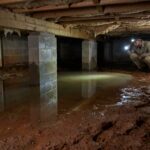Transforming Your Home: Essential Guide to Foundation Repair for Lasting Stability
When it comes to home ownership, few things are as disheartening as discovering that your beloved abode is experiencing foundation issues. You know what they say about foundations; they’re the unsung heroes of your home. They carry the weight of your entire structure and, just like a superhero in a poorly-written script, they do so quietly and without fanfare. So, if your superhero shows signs of wear and tear—cracks in the walls, sloping floors, or doors that simply refuse to open—you might need to strap on your toolbelt and dive into the world of foundation repair.
In this essential guide, we will take you through everything you need to know about foundation repair, how to spot signs of distress, the causes of foundation problems, and most importantly, how to get your home back on solid ground—literally. We’ll keep it professional, but you might find yourself smiling along the way.
Understanding Foundation Issues
First things first, let’s talk about the telltale signs that your foundation is throwing you a silent distress signal. Here are some common indicators you should be on the lookout for:
1. Cracks in Walls: Vertical cracks in the drywall or brick can be normal as homes settle. However, horizontal cracks, or cracks that widen over time, could indicate serious foundation issues.
2. Uneven Floors: If you feel like you’re walking on a ship’s deck rather than your living room, it’s time to investigate. Uneven floors can signal that the foundation is shifting.
3. Doors and Windows Sticking: Struggling to open or close doors and windows? It might not be just a case of poor craftsmanship from the last DIY project—your foundation could be moving.
4. Gaps Around Windows and Doors: Noticeable gaps between frames and walls are bad for aesthetics and could mean something’s off beneath the surface.
5. Water Accumulation: Excess moisture around the foundation can lead to more significant problems over time. Pooling water is like leaving out snacks during a party; eventually, something’s going to get munched on—unfortunately, in this case, it could be your foundation.
Identifying the Causes
Now that you know what to look for, it’s essential to understand what can cause these foundation troubles. While you may be tempted to believe that your house is just having an existential crisis, there are specific factors at play here:
1. Poor Drainage: Water is one of the foundation’s biggest adversaries. When it rains, if your gutters are clogged or land slopes toward your home, all that water will pool around your foundation, causing it to shift and crack.
2. Soil Issues: The type of soil under your home matters immensely. Expansive clay soils can swell when wet and shrink when dry, leading to a rollercoaster effect on your foundation.
3. Tree Roots: Trees are lovely to look at, but their roots can wreak havoc on your foundation. As roots grow, they can disturb soil and even push against the foundation itself.
4. Poor Construction: Sadly, not all builders are created equal. A shoddy foundation job can lead to future headaches that are entirely avoidable.
5. Seasonal Changes: Many homeowners find that their foundations suffer during extreme temperature changes. The freezing and thawing cycles can cause soil movement and settlement, leading to cracks and shifts.
Taking Action: Your Foundation Repair Options
If you find yourself in the position of needing foundation repair, fear not! There are several options at your disposal. Depending on the severity of the issue, you may consider the following approaches:
1. **Foundation Inspection**: Before taking any drastic measures, it’s wise to have a professional perform a thorough inspection. This step will give you a clearer idea of the underlying issues and potential solutions.
2. **Crack Repair**: For minor cracks, you can often use epoxy injections or polyurethane foam to seal up those pesky openings. It’s like giving your foundation a well-needed spa day.
3. **Underpinning**: In cases where the foundation has settled too deeply, underpinning can help. This process involves extending the foundation deeper into more stable soil. Think of it as giving your home an extra pair of legs!
4. **Piering Systems**: For severe shifts in the foundation, piers can be installed to lift the foundation back to its original level. It’s akin to hiring a personal trainer for your home—getting it back in shape and strong!
5. **Drainage Solutions**: Sometimes, the fix isn’t about the foundation itself, but about preventing further issues. Installing proper drainage systems, such as French drains or sump pumps, can keep water away from your foundation for good.
DIY vs. Hiring Professionals
You might be tempted to roll up your sleeves and take on the foundation repair yourself, armed with nothing but a YouTube video and sheer determination. While small repairs might be manageable, significant foundation issues typically require professional intervention. Remember, your home is likely your largest investment. Do you really want to trust it to the local handyman who may or may not think “leveling” is a suggestion?
Hiring a reputable foundation repair specialist can provide peace of mind and ensure that the job is done right. These professionals often come equipped with knowledge, the right tools, and experience that can save you money in the long run. Nevertheless, if you choose to go the DIY route, make sure to do your research and proceed with caution.
Maintaining a Stable Foundation
Once you’ve addressed your foundation issues, the work doesn’t end there! Maintaining a stable foundation is critical for preventing future problems. Here’s how to keep your foundation happy and healthy:
1. **Regular Inspections**: Keep an eye on your foundation and the surrounding areas. Regular inspections can help catch small issues before they become bigger problems.
2. **Proper Landscaping**: Ensure that landscaping directs water away from your home. A slight slope can make all the difference. And remember, no one wants a moat around their house unless it’s for aesthetic purposes—definitely not for water management!
3. **Gutter Maintenance**: Clean your gutters regularly to prevent blockages and overflowing, which can send water cascading down to your foundation.
4. **Watering Practices**: If you live in an area prone to drought, avoid over-watering your plants near the foundation. Conversely, during dry spells, be mindful of the moisture levels to prevent soil shrinkage.
5. **Tree Management**: Keep a watchful eye on trees nearby; they might seem innocent, but their roots can cause havoc if left unchecked. Pruning them can help mitigate potential risks.
Conclusion
Transforming your home isn’t just about picking out the perfect paint color or finding the right light fixtures. It is also about ensuring that your home stands strong, firmly anchored to the ground. By understanding the signs of foundation problems, identifying their causes, and implementing effective repair solutions, you’ll be well on your way to maintaining a stable living environment for you and your family.
Remember, a sound foundation is not only crucial for the longevity of your home but also adds value and boosts your peace of mind. With this guide in hand, you can confidently approach the task of foundation repair and maintenance—keeping your home safe and sound for years to come. So go ahead, don your superhero cape and make sure your foundation is ready to withstand whatever life throws at it!


